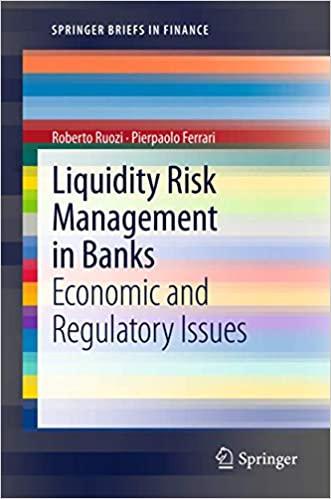Question
Bond Valuation Robert Black and Carol Alvarez are vise presidents of Western Management and codirectors of the companys pension fund management division. A major new
Bond Valuation
Robert Black and Carol Alvarez are vise presidents of Western Management and codirectors of the companys pension fund management division. A major new client, the California League of Cities, has requested that Western present an investment seminar to the mayors of the represented cities. Black and Alvarez, who will make presentation, have asked you to help them by answering the following questions.
- What are a bonds key features?
- What are call provisions and sinking fund provisions? Do these provisions make bonds more or less risky?
- How is the value of any asset whose value is based on expected future cash flows determined?
- How is a bonds value determined? What is the value of a 10-year, $1000 par value bond with a 10% annual coupon if its required return is 10%?
- (1) What is the value of a 13% coupon bond that is otherwise identical to the bond described in Part d? Would we now have a discount or a premium bond?
(2) What is the value of a 7% coupon bond with these characteristics? Would we now have a discount or premium bond?
(3) What would happen to the values of the 7%, 10%, and 13% coupon bonds over time if the required return remained at 10%? [Hint: With a financial calculator, enter PMT, I/YR, FV, and N; then change (override) N to see what happens to the PV as it approaches maturity.]
f. (1) What is the yield to maturity on a 10-year, 9%, annual coupon, $1000 par value bond that sells for $887.00? that sells for $1134.20? What does the fact that it sells at a discount or at a premium tell you about the relationship between rd and the coupon rate?
(2) What are the total return, the current yield, and the capital gains yield for the discount bond? Assume that it is held to maturity and the company does not default on it. [Hint: Refer to Footnote 8 for the definition of the current yield and to Table 7-1.]
g. What is interest rate (or price) risk? Which has more interest rate risk, an annual payment 1-year bond or a 10-year bond? Why?
h. What is reinvestment rate risk? Which has more reinvestment rate risk, a 1-year bond or a 10-year bond?
i. How does the equation for valuing a bond change if semiannual payments are made? Find the value of a 10-year, semiannual payment, 10% coupon bond if nominal rd=13%.
j. Suppose for $1000 you could buy a 10%, 10-year, annual payment bond or a 10%, 10-year, semiannual payment bond. They are equally risky. Which would you prefer? If $1000 is the proper price for the semiannual bond, what is the equilibrium price for the annual payment bond?
k. Suppose a 10-year, 10%, semiannual coupon bond with a par value of $1000 is currently selling for $1135.90, producing a nominal yield to maturity of 8%. However, it can be called after 4 years for $1050. (1) What is the bonds nominal yield to call (YTC)? (2) If you bought this bond, would you be more likely to earn the YTM or the YTC? Why?
l. Does the yield to maturity represent the promised or expected return on the bond? Explain.
m. These bonds were rated AA- by S&P. Would you consider them investment-grade or junk bonds?
n. What factors determine a companys bond rating?
o. If this firm were to default on the bonds, would the company be immediately liquidated? Would the bond-holders be assured of receiving all of their promised payments? Explain.
Step by Step Solution
There are 3 Steps involved in it
Step: 1

Get Instant Access to Expert-Tailored Solutions
See step-by-step solutions with expert insights and AI powered tools for academic success
Step: 2

Step: 3

Ace Your Homework with AI
Get the answers you need in no time with our AI-driven, step-by-step assistance
Get Started


